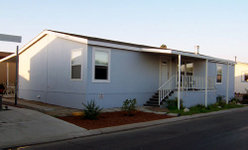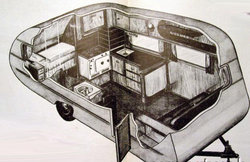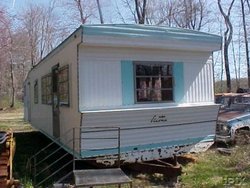Mobile home

Mobile homes are housing units built in factories, rather than on site, and then taken to the place where they will be occupied, usually by being carried by tractor-trailers over public highways. They are usually much less expensive than site-built homes, and are often associated with rural areas and high-density developments sometimes referred to as trailer parks.
Although the name "mobile" implies that these houses will move around, they usually are placed in one location — often a rented lot — and left there for the life of the structure. However, they do retain the ability to be moved, and this is in fact required in many areas. Behind the cosmetic foundation-work normally fitted at installation to hide the base, there are strong road-going trailer frames, axles, wheels and tow-hitches.
The two major forms of mobile homes are single-wides and double-wides. "Single-wides" are sixteen feet or less in width and can be towed to their site as a single unit, whereas "double-wides" are twenty-four feet or more wide and are towed to their site in two separate units, which are then joined together. Triple-wides, although rarer, are also manufactured.
Mobile homes are not self-propelled vehicles containing housekeeping space inside them: Such vehicles are more properly referred to as motor homes or RVs.
History
This form of housing goes back to the early years of automobiles and motorized highway travel, and derives from the travel trailer, a small unit with permanently attached wheels often used for camping. Larger units intended to be used as dwellings for several months or more in one location came to be known as house trailers, a term now considered to be somewhat derisive.

The original focus of this form of housing was its mobility, and units were initially marketed primarily to persons whose lifestyle was necessarily mobile, such as construction workers. However, largely beginning in the 1950s, mobile homes began to be marketed primarily as an inexpensive form of housing designed to be set up and left in a location for long periods of time or even permanently installed with a masonry foundation. The introduction of the 10-foot wide mobile home in 1956 (previously, units had been 8 feet or less in width) helped solidify the line between mobile homes and travel trailers, as the larger, wider units required the services of a professional trucking company to transport, and could no longer be moved with simply an automobile. In the 1960s and '70s, mobile homes became longer and wider, thus diminishing the "mobility" aspect of the units even further. Today, the average mobile home, once it has reached its final destination, is never moved again.

Many persons who could not afford a traditional site-built home or did not desire to commit to spending a relatively large sum of money for housing began to see mobile homes as a viable alternative for long-term housing needs, and the units were often marketed as an alternative to apartment rental. However, the tendency of the units of this era to depreciate rapidly in resale value made loans using them as collateral far riskier than traditional home loans, and terms were generally limited to less, often far less, than the thirty year term typical of the general home-loan market, and interest rates were generally higher, often considerably so. In other words, mobile home loans resembled in many ways motor vehicle loans far more than traditional home mortgages.
Legal complications
The rise of the mobile home brought with it complications to a legal system which had not been set up to contemplate it. At first, mobile homes tended to be taxed as vehicles rather than real estate, which often resulted in very low property tax rates for those who lived in them. This led to moves by taxing jurisdictions to reclassify them as real property for taxation purposes.
However, rapid depreciation often resulted in their occupants paying far less in property taxes, even with this change, than had been anticipated and budgeted for many homeowners to pay. The ability to move many mobile homes into a relatively small area very rapidly often resulted in strains to the infrastructure and governmental services of the affected areas, sometimes resulting in inadequate water pressure and sewage disposal and highway congestion. This led most jurisdictions to take steps to limit the number of mobile homes within them, most often by placing limitations on the size and density of developments that could be made utilizing them.
As noted above, early mobile homes, even well-maintained ones, tended to depreciate in value over time more like motor vehicles rather than appreciate in value, as is more typical with site-built homes. The arrival of mobile homes in an area tended to be regarded with alarm, particularly by the owners of more valuable real estate who often feared, with some reason, that their property values could become depressed.
This combination of factors has led most jurisdictions to restrict even further by zoning regulations the areas in which mobile homes can be placed, as well the number and density of mobile homes permissible on any given site. Often other restrictions, particularly minimum size requirements, limitations on exterior colors and finishes, and foundation mandates were enacted as well. There are many jurisdictions that do not allow any future mobile homes, and others have strongly limited or forbidden entirely all single-wide models, which tend to depreciate more rapidly in value than modern double-wide models.
Mobile home parks
Modern mobile home parks are not necessarily the trailer parks of the past, which were often associated with being substandard and frequently with good reason. Most have standards with regard to the permissible size and styles of homes which may be set up within them, and many are somewhat similar to more traditional subdivision developments with mobile homes in place of traditional site-built ones. In some, including most of the more desirable ones, all of the homes are owned by the individual occupants and only the spaces, or pads are rented, not the units themselves. Developments in which the mobile homes are sold on lots that are also purchased by the buyers are almost indistinguishable from traditional subdivisions and far removed from the typical image of a trailer park. In lower-end parks, some or all of the units tend to be rental units owned by the operators of the park. These sorts of developments are often considered to be particularly objectionable by the owners of surrounding property.
Newer mobile homes, particularly double-wides, tend to be built to much higher standards than their predecessors and meet the building codes applicable to most areas. This has led to a reduction in the rate of value depreciation of most used units.
Additionally, as the industry has parted farther from its travel trailer roots, modern mobile homes tend to be built from materials similar to those used in site-built homes rather than inferior, lighter-weight ones, and are also more likely to physically resemble site-built homes, with often the primary way of differentiation being that mobile homes tend to have less of a roof slope so that they can be readily transported underneath bridges and overpasses en route to being set up.
The number of double-wide units sold now exceeds the number of single-wides, in part due to the zoning restrictions alluded to above and in part due to the spaciousness and appointments available in many double-wide units, which in the higher-end are now often comparable to fairly luxurious site-built homes. Single-wide units are still popular in some areas, primarily rural ones, where few restrictions against them have been promulgated, and are frequently used as temporary housing in areas affected by natural disasters, when restrictions are often temporarily waived.
Modular homes
Mobile homes are often confused with but are not identical to modular homes, which are usually hauled to their use locations on flat-bed trucks rather than being towed, and lack axles and an automotive-type frame typical of mobile homes. (Both are properly referred to as manufactured housing.)
Most zoning restrictions applying to mobile homes have been found not to be applicable or only partially to modular homes, often after considerable litigation on the topic by affected jurisdictions and by plaintiffs failing to ascertain the difference. Most modern modular homes, once fully assembled, are indistinguishable from site-built homes, as their roofs are usually transported as separate units, making the telltale mobile home roofline unnecessary. The market for modular homes is likely to grow in the future as the legal differentations between the two becomes more codified.
The traditional mobile home industry would seem to have a bright future as well, as the demand for housing continues to grow, the price of housing continues to increase rapidly, and the quality and features lead to greater acceptance by a growing segment of the marketplace. Additionally, insurers and lenders are now more likely to treat the higher-end double wide more as they would a traditional home with regard to coverages and lending practices.
Trivia
During a renovation of the Arkansas governor's mansion, then-Governor Mike Huckabee and his family lived in a triple-wide manufactured home on site, donated by the state manufactured home builders association. Though the move was criticized by many who believing it played to stereotypes of rural Arkansas, Huckabee agreed to the idea because the industry was important to Arkansas both in terms of sales and employment.
